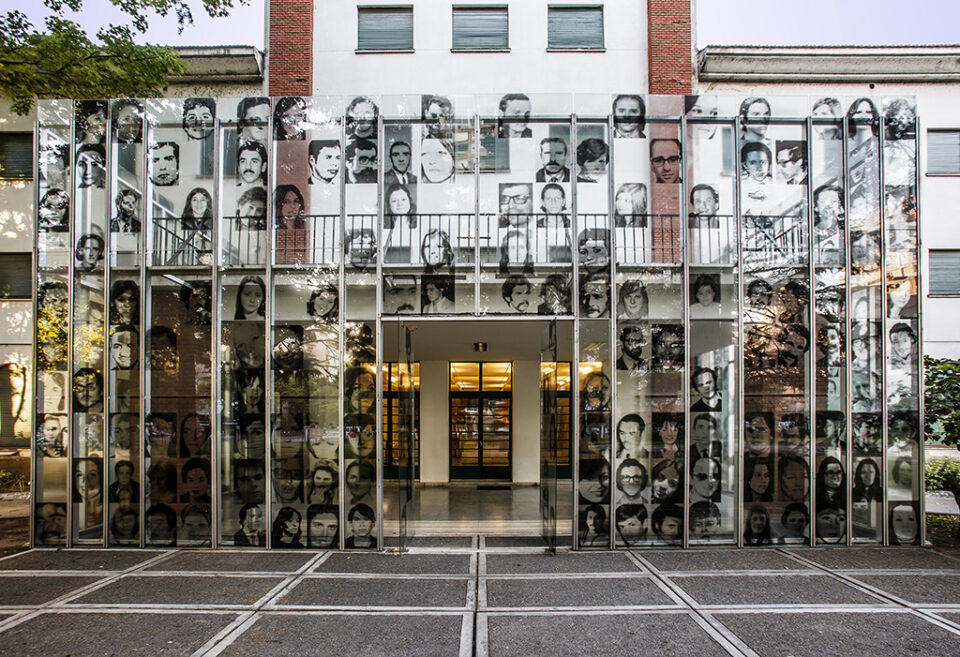Argentina’s Ministry of Justice announced on Wednesday that it would be taking over and repurposing a major building within the Navy Mechanics School (ESMA) memory site.
ESMA was a clandestine detention center during the dictatorship which governed Argentina from 1976 and 1983. Approximately 5,000 people are estimated to have spent time in ESMA during these years; many were tortured and murdered.
After the dictatorship, ESMA became a museum and historical memory site and was also named a UNESCO World Heritage Site.
Now, President Javier Milei’s government has announced that, in line with the new Federal Criminal Procedure Code which is due to be implemented in Buenos Aires on August 11, “a building of more than 5,000 square metres located in the former ESMA has been made available to federal prosecutors.”
According to La nueva Mañana, the building in question is the “Officers’ casino,” which is the building currently housing ESMA’s museum. The “casino,” also described as the “Officer’s Quarters” on the ESMA website, is said to have had two functions. It was both “a space of enjoyment and rest for higher-ranking Navy officers” and “a place for the confinement of the detained-disappeared.”
The new criminal code seeks to restructure the criminal justice system through measures such as reducing trial times and granting the prosecutor’s office greater power. Under the code, the prosecutor’s office will lead investigations and prosecution processes, while judges will be responsible for overseeing court proceedings and ensuring that defendants’ rights are fulfilled.
Argentina’s Justice Ministry stated that ESMA has “previously been used for ideological programs and political party activities,” but will now be used “to strengthen judicial infrastructure and to contribute directly to the fight against insecurity.”
The ministry continued: “Our decision is part of President Javier Milei’s mandate to eliminate unnecessary expenses, downsize the state, and redirect existing resources towards what is really important: a quick, efficient justice system which is at the service of Argentinians.”
The statement concluded, “We reaffirm our commitment to providing judges and prosecutors with all the necessary tools so they can imprison criminals.”
The decision has been criticized by Argentine lawmaker Victoria Montenegro, whose parents were both “disappeared” during the dictatorship.
She told Perfil that it was “impossible” to imagine prosecutors summoning “people deprived of their liberty” to the ESMA site. She continued: “Can you imagine someone thinking of putting an office inside a Holocaust memorial where people in chains would be brought in?”
She claimed that Justice Minister Mariano Cúneo Libarona has “no authority to transfer the Public Prosecutor’s Office to the ESMA.”
Montenegro also accused the government of “trivializing evil” and of conducting a “systematic attack on everything related to human rights policy in a much broader sense.”
The Union of Judicial Workers of the Argentine Republic (SITRAJU) has also criticized the decision, stating: “The role of the federal criminal justice system is not to ‘imprison criminals’ and ‘combat insecurity.’ Its function is to resolve conflicts by upholding the rights and guarantees of our National Constitution.”
SITRAJU added: “The Judiciary and the Public Prosecutor’s Office must be independent of the Executive Branch. This type of message conflates government interests with judicial functions, in clear tension with the republican principle of the separation of powers.”
The announcement follows the January closures of two historical memory sites: the Haroldo Conti Library and Museum, which is dedicated to the writer who was “disappeared” during the dictatorship, and the Virrey Cevallos memory site, which is a former clandestine detention center.
In March, a judge blocked plans by the Argentine Navy to destroy documents which were thought to contain potentially vital information about crimes committed during the dictatorship.
In April, Milei’s government announced that it would freeze funding to ESMA for sixty days, reportedly leaving 176 workers without their salaries for March.
Featured image credit:
Image: Entrance to the ESMA museum
Photographer: Camilo Del Cerro
Source: https://commons.wikimedia.org/wiki/File:Museo_Sitio_de_Memoria_ESMA,_ex_Centro_Clandestino_de_Detenci%C3%B3n,_Tortura_y_Exterminio.jpg
License: https://creativecommons.org/licenses/by-sa/4.0/deed.en
The post Argentina’s Justice Ministry to repurpose UNESCO-recognized memory site appeared first on Argentina Reports.
The post Argentina’s Justice Ministry to repurpose UNESCO-recognized memory site appeared first on Latin America Reports.




